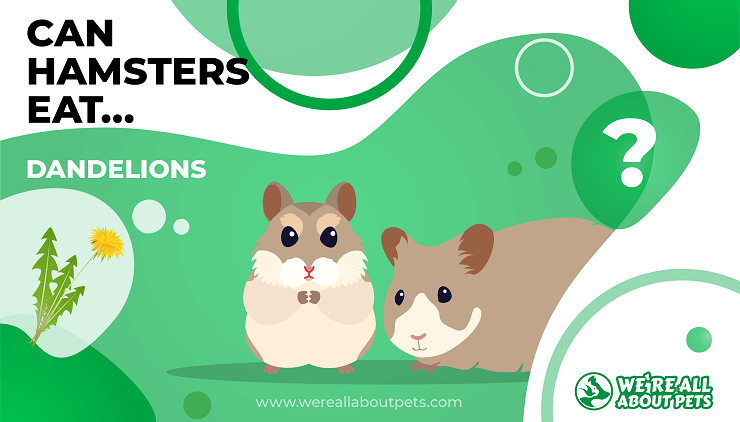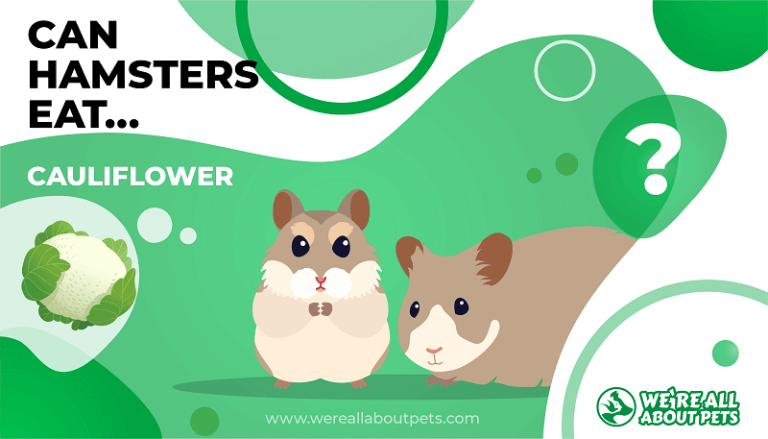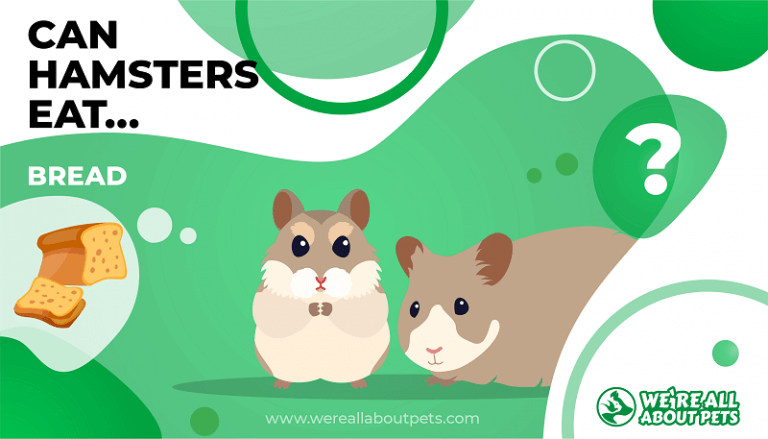Can Hamsters Eat Radishes?
This page contains affiliate links. We may earn money or products from the companies mentioned in this post through our independently chosen links, which earn us a commission. Learn More
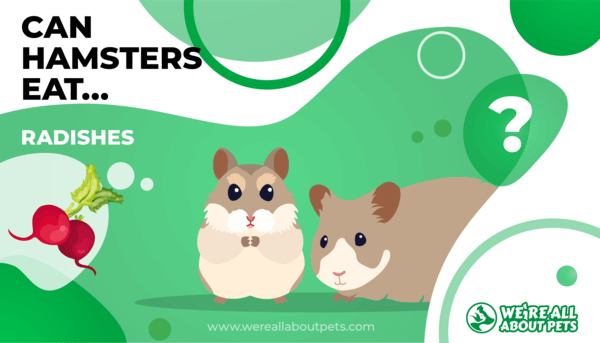
Crunchy, zesty radishes make a fantastic addition to your salad, but is it OK to share them with your pet?
Can hamsters have radishes, and if so, how much can they have at one go? And, how often can you give radish to a hamster, anyway?
As it turns out, radishes are OK for hamsters – but only in very small amounts and only once in a while.
Keep reading to learn all about radishes for hamsters. You’ll be ready to offer them this new, exciting treat in no time!
Radish Nutrition Stats
Radishes might be mostly water, but they’re big on flavor.
A cup of sliced radishes provides:
- 19 calories
- 4 g carbohydrates
- 9 g fiber
- .8 g protein
- .1 g fat
Radish Nutritional Facts
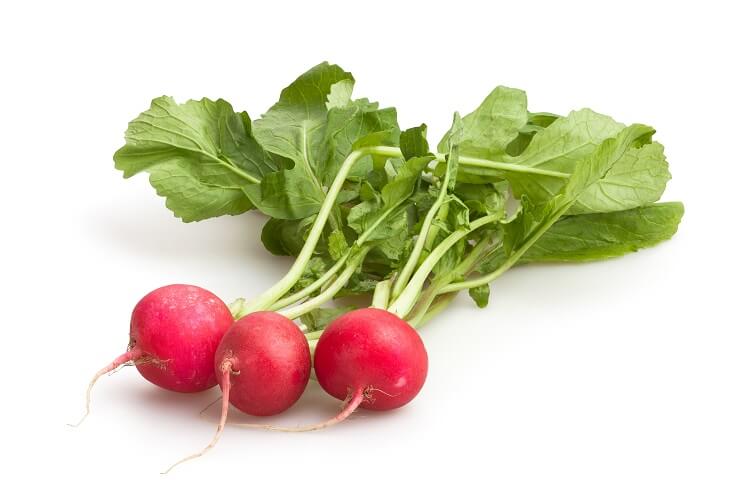
Even though they’re low in calories, radishes are nutritious. Like other root vegetables, they absorb minerals from the soil, and they provide plenty of vitamins, too.
That same one-cup serving of sliced radishes offers approximately:
- 2 mg vitamin C
- 1 vitamin A
- 270 mg potassium
- 29 mg calcium
- 6 mg magnesium
- .4 mg iron
- 5 mcg vitamin K
- 29 mcg folate
- 3 mg phosphorus
Can Hamsters Have Radishes?
You might be surprised to learn that radishes are OK for hamsters! It’s true – hamsters can have radishes, but only a little at a time. Be sure that you wash the radishes well before you prep them for your hamster, and be absolutely sure that they’re fresh since spoiled food isn’t safe.
Are Radishes Good For Hamsters?
As radishes are low in sugar while providing some vitamins and minerals, they’re definitely good for your hamster. Do take care when offering radish to your hamster for the very first time, since this treat is one that can cause some unpleasant side effects if it’s overeaten.
Do Hamsters Like Radishes?
Good question! Just as some people love radishes and enjoy crunching on them, some hamsters are fond of radishes. And just like some people can’t stand the thought of eating radishes, some hamsters turn their noses up when radish treats are offered.
How Much Radish Can A Hamster Eat?
The short answer is “not much!”
Here’s how much radish a to feed your hamster:
| Age | Amount |
| Baby hamster | None |
| Adult hamster | 1 thin radish slice |
If you have a dwarf hamster or another tiny hamster breed, you’ll want to give them even less than a slice – a quarter of a thin radish slice might be just enough. Think of it like pickles – too much can lead to trouble!
There’s more: You’ll want to introduce this treat slowly, offering about ¼ of the total portion at first and watching for signs of diarrhea and an upset tummy.
Radishes can cause gas and bloating, so tiny bits are best!
If your hamster seems fine and likes the radish you’ve given them, then you can gradually increase their portion size until they’re eating the full amount. Just make sure you don’t offer it on the same day as you provide other treats that can cause gas – broccoli, cauliflower, and brussels sprouts come to mind!
How Often Can A Hamster Eat Radishes?
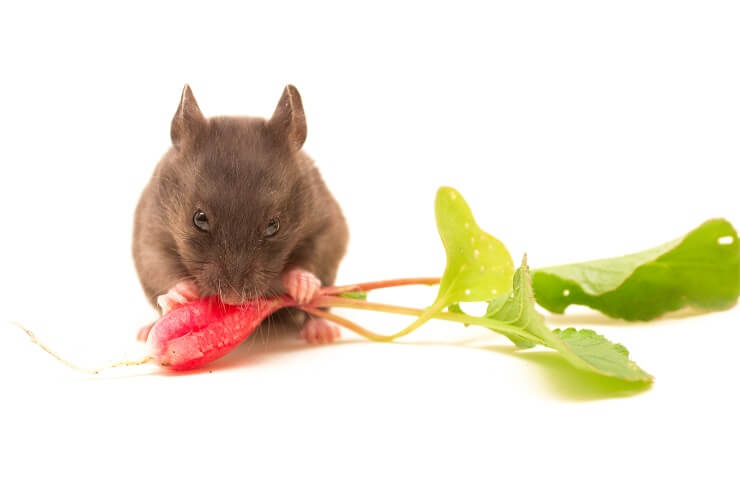
Radishes are a “once in a while” treat for hamsters. You can offer a little bit once or twice per week.
If your hamster just arrived home from the pet store, you’ll want to introduce them to other, milder fresh foods before you give them their first little bit of radish. Start with something easier to digest such as cucumber or spinach.
Give them just a tiny bit every other day the first week, then gradually increase to every day over the next week. Once your pet has become accustomed to eating fresh food, you can begin to introduce radishes.
The Correct Diet Is Important
A hamster’s natural diet contains all kinds of surprising things: these adorable creatures are omnivores!
Hamsters are capable of eating animal protein and they love insects so offering a few dried mealworms or a tiny bit of cooked egg is a nice way to supplement your pet’s diet.
Besides these unexpected hamster treats, here’s what else to feed your pet each day:
- Hamster pellets: Choose a nutritionally complete hamster food with an adequate amount of vitamin C, as hamsters aren’t capable of making their own. Check the package for the correct serving size.
- Fresh Timothy hay: Even though it isn’t considered “necessary,” hay helps your hamster’s mental health and dental health! It satisfied the need for constant nibbling and it’s the perfect material for instinctive nesting and tunneling behaviors.
- A small amount of birdseed: Offer your hamster just about a teaspoon per week to increase their healthy fat intake and give them a little more variety.
- Very small portions of fruit and vegetables: Give only the amount your hamster will eat all at once, so they don’t hoard it. Fresh food gets moldy fast and when stashed in your hamster’s bedding, it can spoil and make your hamster sick. Remove any excess as soon as your hamster finishes nibbling.
- Unlimited amount of clean, fresh water: Water is essential, 24/7. Be sure to take a moment each day to rinse and refill your hamster’s drinking bottle.
Since your hamster’s teeth never stop growing, it’s important to make sure that they have access to safe, chewable items 24/7. Untreated softwood, coconut shell, unbleached loofah, hamster toys, and hay cubes are ideal.
What Are Other Healthy Alternatives To Radishes In A Hamster’s Diet?
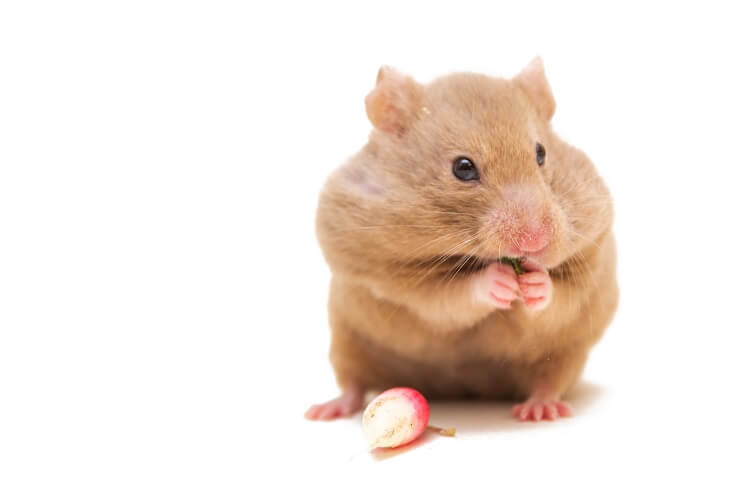
All rodents – including hamsters – eat a vast variety of foods.
You can use our list of vegetables hamsters like as a jumping-off point when deciding which treats to try next:
- carrot
- carrot tops
- beets
- beet tops
- potato (cooked only)
- sprouts
- watercress
- green beans
- cucumber
- zucchini
- celery
- bell pepper
- parsnip
- asparagus
- baby corn
- sweet corn
- cabbage
- artichoke
- spinach
- butter lettuce
- bibb lettuce
- cilantro
- basil
- mint
- parsley
- romaine
- arugula
- swiss chard
- endive
- escarole
- rocket
- bok choy
- yu choy
- buttercrunch lettuce
- summer squash
- winter squash
- pumpkin
- sweet potato
- tomato
- broccoli
- broccolini
- cauliflower
- okra
These veggies are just a starting point: There are many, many other foods that your hamster will enjoy!
Before offering anything new, remember to spend a few minutes reading about whether it’s safe for hamsters. Not only will this help you avoid offering anything that’s toxic, it’s the best way to find out how much of each food your hamster should eat as well as how often they should have it.
Now that you know giving your hamster radishes (just in small amounts!) is a fun way to add variety to their diet, what will you give your pet next?
Frequently Asked Questions
Are radishes safe for hamsters?
Yes, just remember to wash the radishes well and be sure that they’re fresh.
Can radishes make my hamster sick?
Since radishes can cause gas and diarrhea when your hamster eats too much at once, it’s important to be careful when introducing them. It’s just as important to offer the correct amount! So long as you’re careful, radishes can be a healthy addition to your hamster’s diet.
Can my hamster eat radish tops?
There are tons of vitamins and minerals in radish tops and if your hamster likes the flavor, they can have a leaf or two. Be sure to wash the radish tops well before giving them to your hamster and like all other fresh foods, be sure to introduce these spicy leaves to your pet gradually.






